Cerebellum and Muscle Spindles
1/79
There's no tags or description
Looks like no tags are added yet.
Name | Mastery | Learn | Test | Matching | Spaced |
|---|
No study sessions yet.
80 Terms
What do muscle spindles do?
Detect change in muscle length and velocity

What are the components of muscle spindles?
- Intrafusal fiber
- Afferent sensor endings
- Efferent motor ending
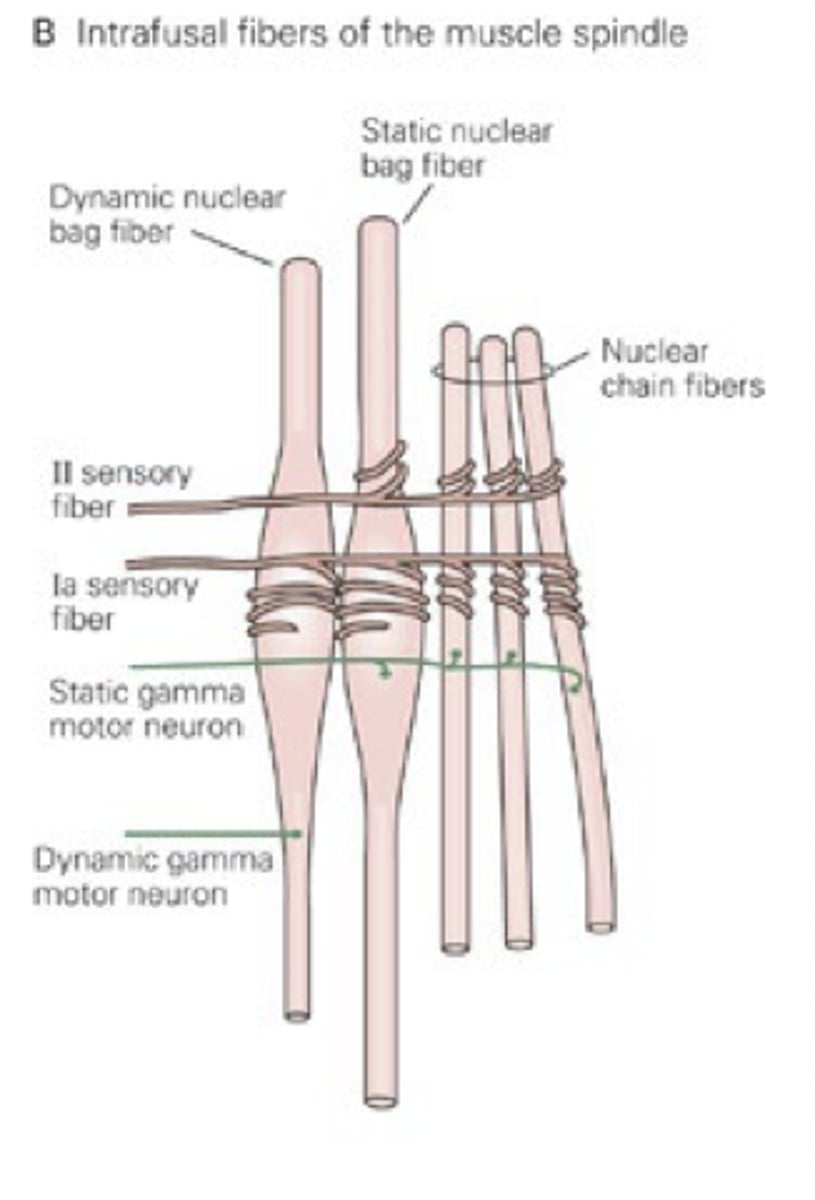
What are intrafusal fibers?
component of muscle spindles
- 3 types
ends are contractile, center region is non-contractile
What are the 3 types of intrafusal fibers?
- Dynamic nuclear bag
- Static nuclear bag
- Nuclear chain fibers
What are intrafusal fibers innervated by?
gamma motor neurons (efferents)
Type Ia and type II sensory fibers (afferents) provide sensory information back to where?
the spinal cord
Activities that stretch extrafusal fibers also stretch what and why?
intrafusal (muscle spindle) fibers due to them lying parallel or embedded into the skeletal fibers
How do intrafusal fibers fire?
tonically
When to intrafusal fibers increase there firing rate?
in response to stretch
What adjusts the sensitivity of muscle spindles?
gamma motor neurons
What are type Ia sensory axons called and what do they innervate?
primary receptors
innervate all 3 types of intrafusal fibers:
- dynamic nuclear bag
- static nuclear bag
- nuclear chain fibers
What are type II sensory axons called and what do they innervate?
secondary receptors
innervate 2 types of intrafusal fibers:
- static nuclear bag
- nuclear chain fibers
How does co-activation work during planned movements?
upper motor neurons usually stimulate alpha and gamma motor neurons simultaneously
activity of gamma motor neurons keeps muscle spindles under proper tension while muscles are shortened
What are GTOs? What do they do?
Golgi Tendon Organs
Provide information about tension in tendons
How do GTOs work?
Type Ib sensory fibers synapses with inhibitory interneuron which causes inhibition of muscle in which it lies
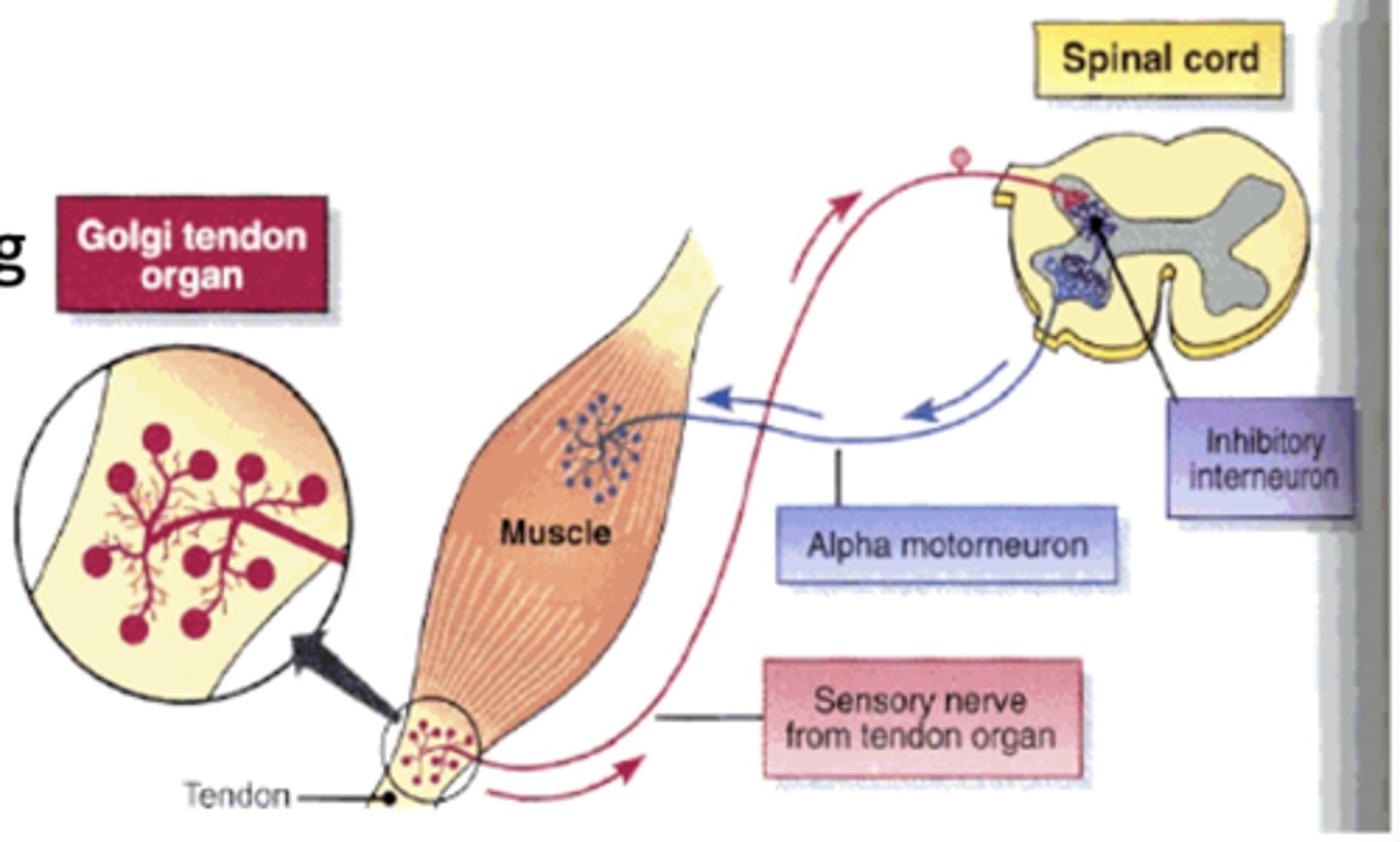
What does the GTO pathway also receive input from?
- Muscle spindles
- Cutaneous receptors
- Joints
- Descending pathways
In simple terms, what is the function of the cerebellum?
Feedback system for motor control
While the cerebellum is only 10% of the brain's volume it contains what?
50% of the total neurons in the CNS
The cerebellum's control is mostly...
ipsilateral
What should you think about when you think about the cerebellum?
Rule of 3s
- 3 Parts
- 3 Lobes
- 3 Functional divisions
- 3 Cellular layers
What are the functions of the cerebellum?
- Coordination
- Balance and Posture
- Motor Learning
- Sensory processing
- Cognition/memory
How do you define coordination?
muscles fire at the right time, in the right sequences and with the appropriate intensity to accomplish a fluid movement or action
How do you define how balance and posture work?
gets input related to where body is in space (proprioception), and changes in position (vestibular input)
How do you define motor learning?
practice or experience leads to permanent changes in the capability for producing skilled action. Complex function that includes several parts of the brain including the cerebellum
What happens with sensory processing when the cerebellum gets damaged?
when the cerebellum gets damaged it spares the primary sensory function but impairs ability to use sensory information to refine movement
How does a damaged cerebellum effect cognition/memory?
still under investigation but cerebellar damage linked to impaired control of emotional behavior
How does the cerebellum function as a comparator?
- part of a feedforward control system
- compares movement being performed to the movement that is desired
- Programs voluntary movement (especially skilled movement)
- Helps prepare the body for a particular motor act before the movement occurs
- Seems to "encode" the end point of movement
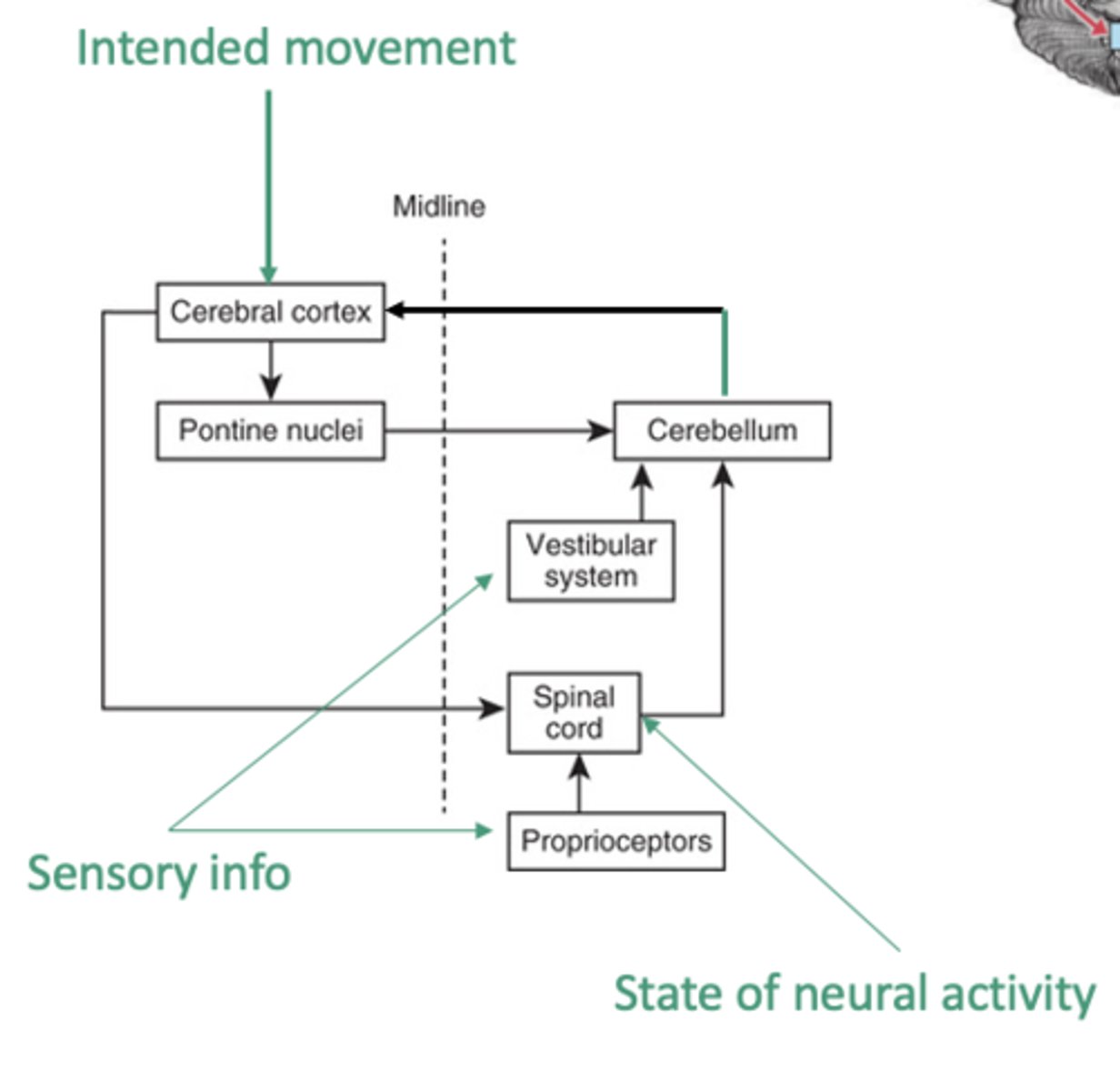
What is the cerebellar peduncle?
bundle of axons that connects the cerebellum to the brainstem
What are the 3 cerebellar peduncles?
- Superior
- Middle
- Inferior
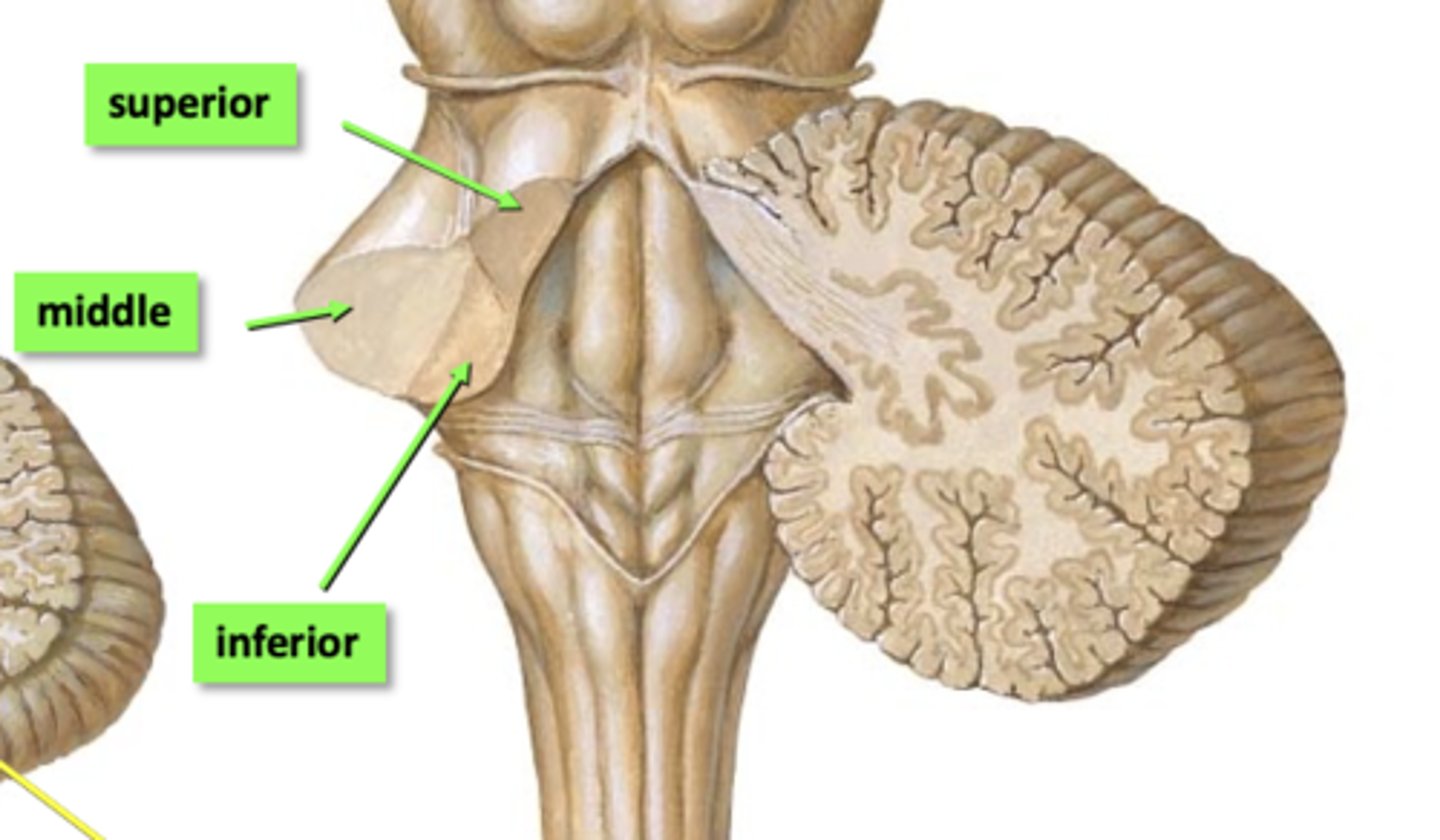
What are the 2 systems to label the parts of the cerebellum?
- Anatomical description
- Functional description
How do you label the cerebellum using an anatomical description?
Two hemispheres + Vermis
3 Lobes:
- Anterior
- Posterior
- Flocculonodular

How do you label the cerebellum using a functional description of divisions?
- Vestibulocerebellum (flocculonodular lobe)
- Spinocerebellum (vermis and paravermis)
- Cerebrocerebellum (lateral portions of the hemispheres)

What is the vestibulocerebellum?
- Consists of the flocculus & nodulus
- Has connections with the vestibular system
What is the function of the vestibulocerebellum?
- Maintenance of balance, posture and equilibrium (via vestibulospinal and reticulospinal tracts)
- Control of eye movements

Damage to the vestibulocerebellum results in...
- Truncal ataxia
- Wide-based
- Staggering gait
- Nystagmus
What is nystagmus?
involuntary oscillating eye movements
What is the spinocerebellum?
Consists of 2 regions:
- Vermal
- Paravermal
Receives proprioceptive info from the spinal cord
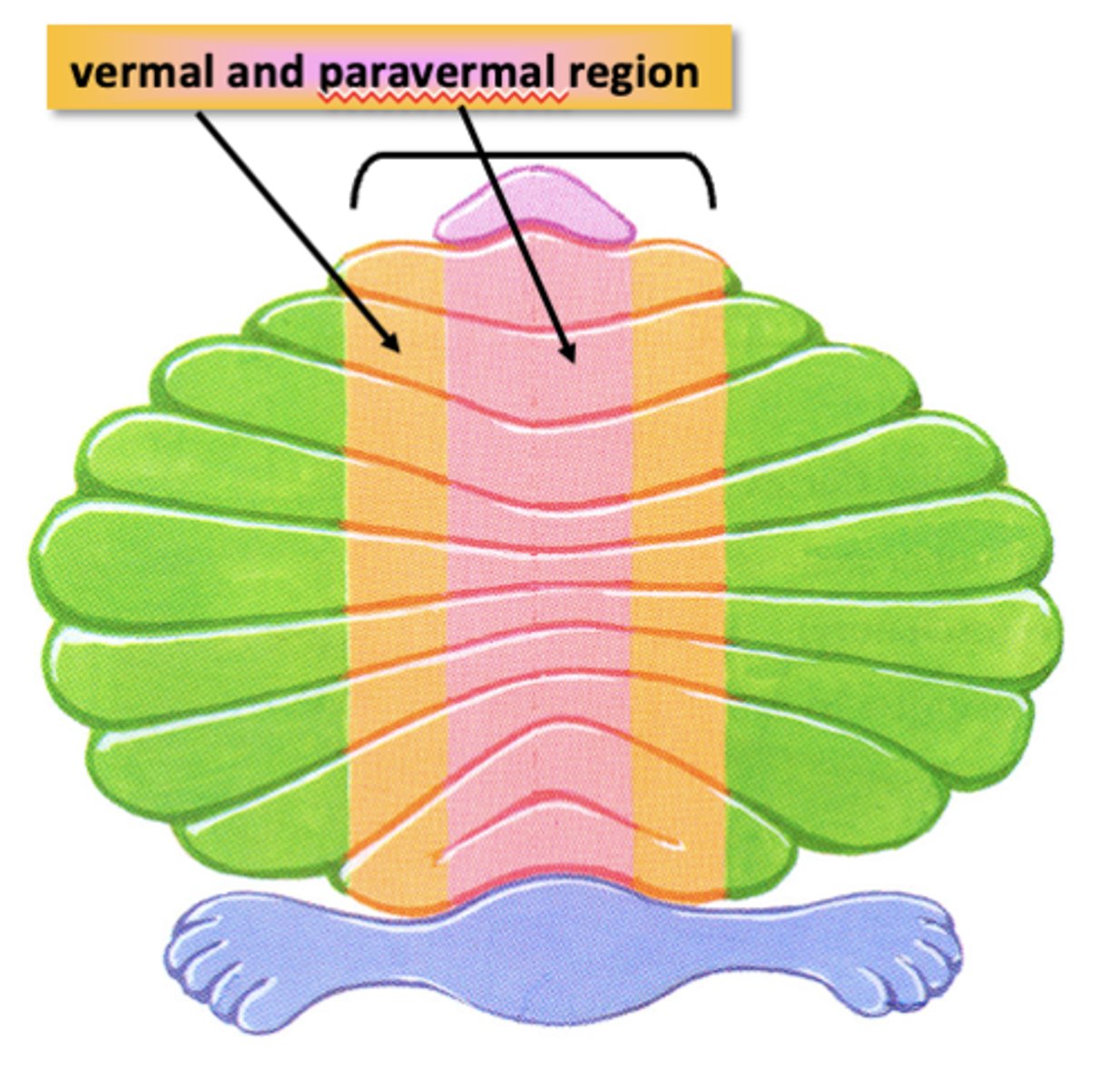
What is the function of the spinocerebellum?
- Regulate posture and adjust limb movements
- Comparator

Damage to the spinocerebellum results in...
- Gait ataxia (as if drunk)
- Impaired heel-shin test
- Hypotonia
often seen in alcoholics (anterior lobe syndrome)
What is the cerebrocerebellum?
consists of lateral hemispheres
receives information from cerebral cortex

What is the function of the cerebrocerebellum?
planning movements of limbs, especially precise distal movements, timing
Damage to the cerebrocerebellum results in...
combination of deficits in coordination of voluntary movements
The cerebrocerebellum works in collaboration with...
motor planning areas and the basal ganglia
What does the cerebrocerebellum help decide?
when movement pattern is initiated and when terminated (coordination)
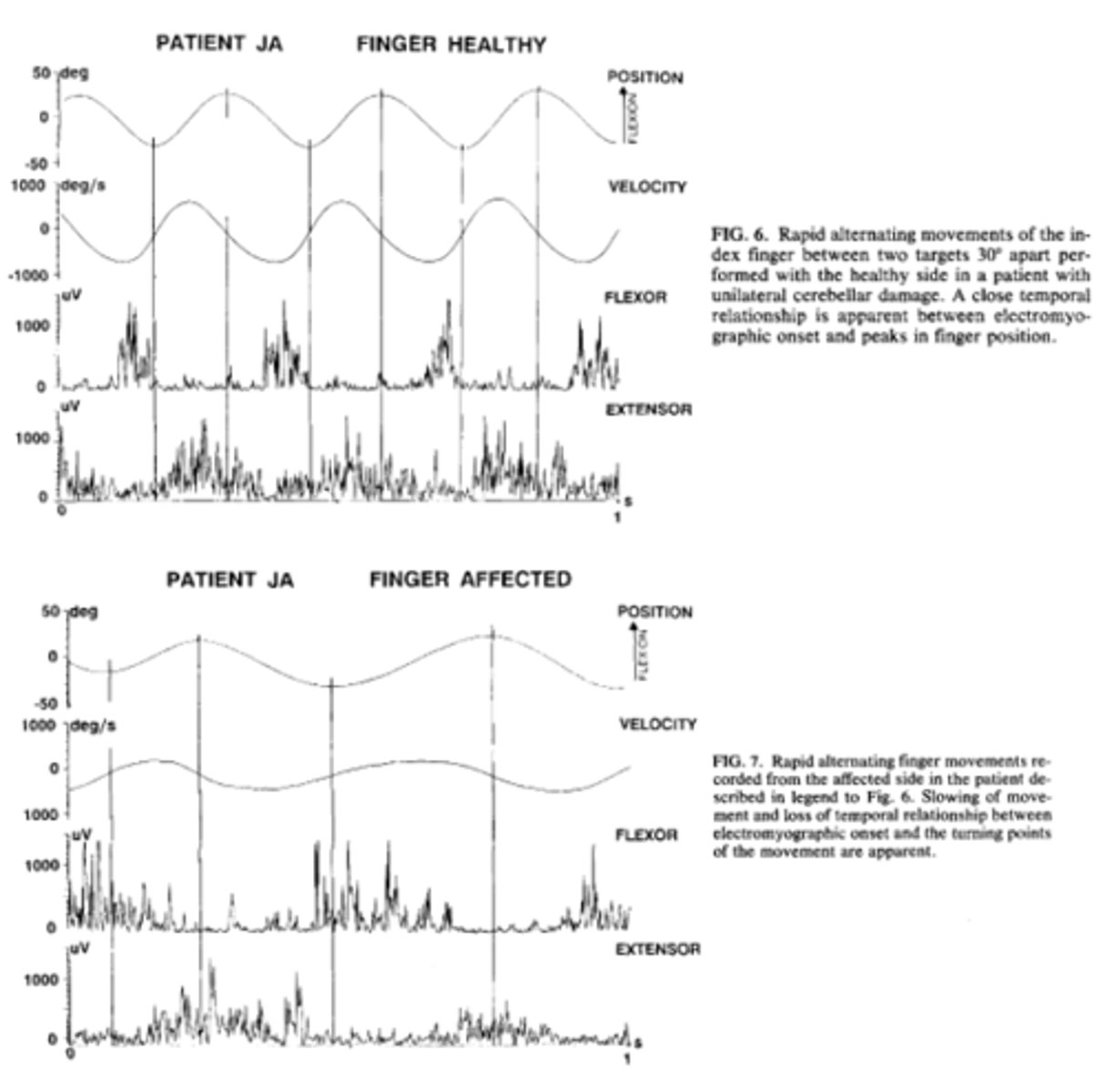
What specific symptoms and impairments would you see in a patient with damage to the cerebrocerebellum?
- Ataxia
- Decompositions (Asynergia)
- Intention tremor
- Dysmetria
- Dysdiadochokinesia
What is ataxia?
loss of coordination of movements
What is decomposition (Asynergia)?
loss of coordination of groups of muscles
Therefore, movements performed in a sequence of component parts rather than a single, smooth activity
What is an intention tremor?
a tremor which worsens as one reaches for a target
What is dysmetria?
inability to gauge distance
What is dysdiadochokinesia?
inability to perform rapid alternating movements
What is the cellular organization of the cerebellum?
- Mossy fibers
- Climbing fibers
- Granule cells
- Purkinje neurons

What are granule cells?
axons which bifurcate to form parallel fibers
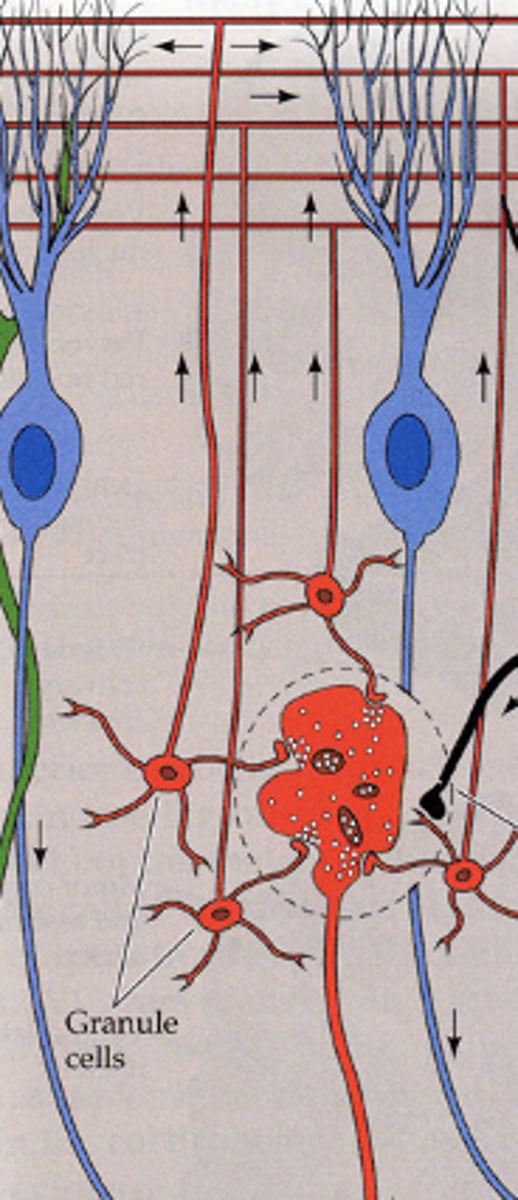
What are purkinje neurons?
large neurons with extensive dendritic trees

What are the 3 layers of the cerebellar cortex?
- Molecular layer
- Purkinje cell layer
- Granular layer

What is contained within the molecular layer of the cerebellar cortex?
axons from granule cells and dendrites from purkinje cells
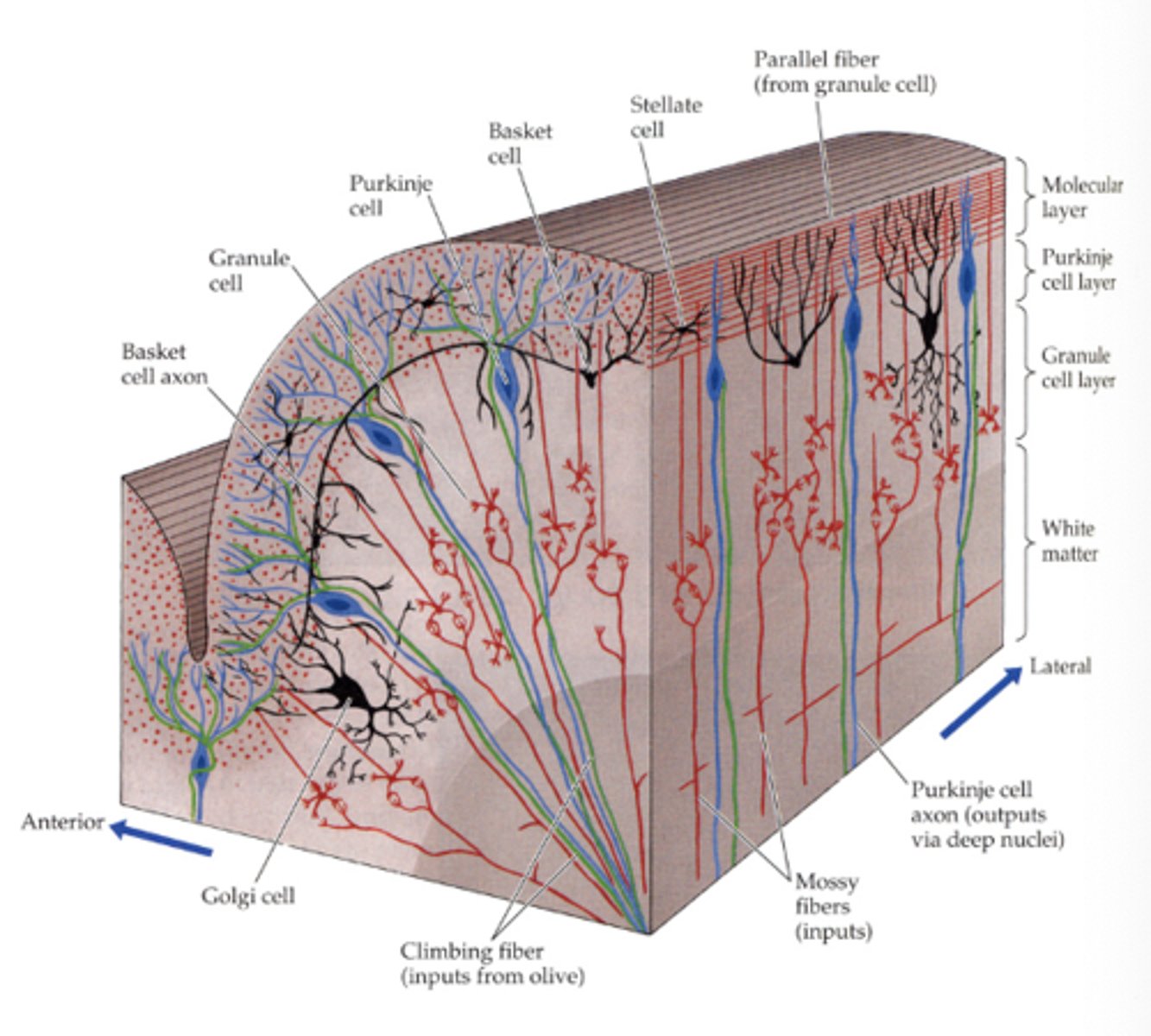
What is contained within the purkinje cell layer of the cerebellar cortex?
cell bodies of purkinje neurons
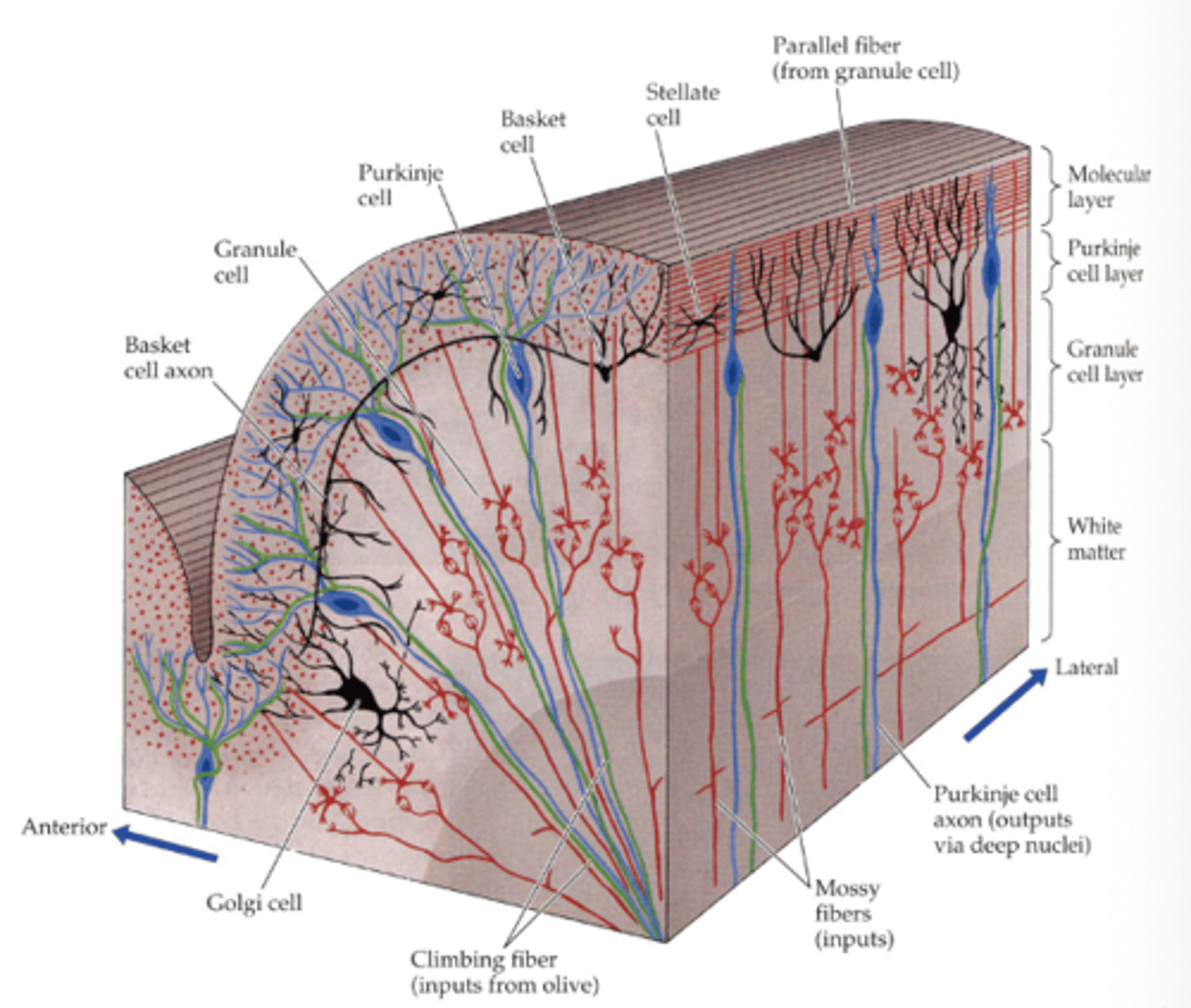
What is contained within the granule layer of the cerebellar cortex?
granule cells
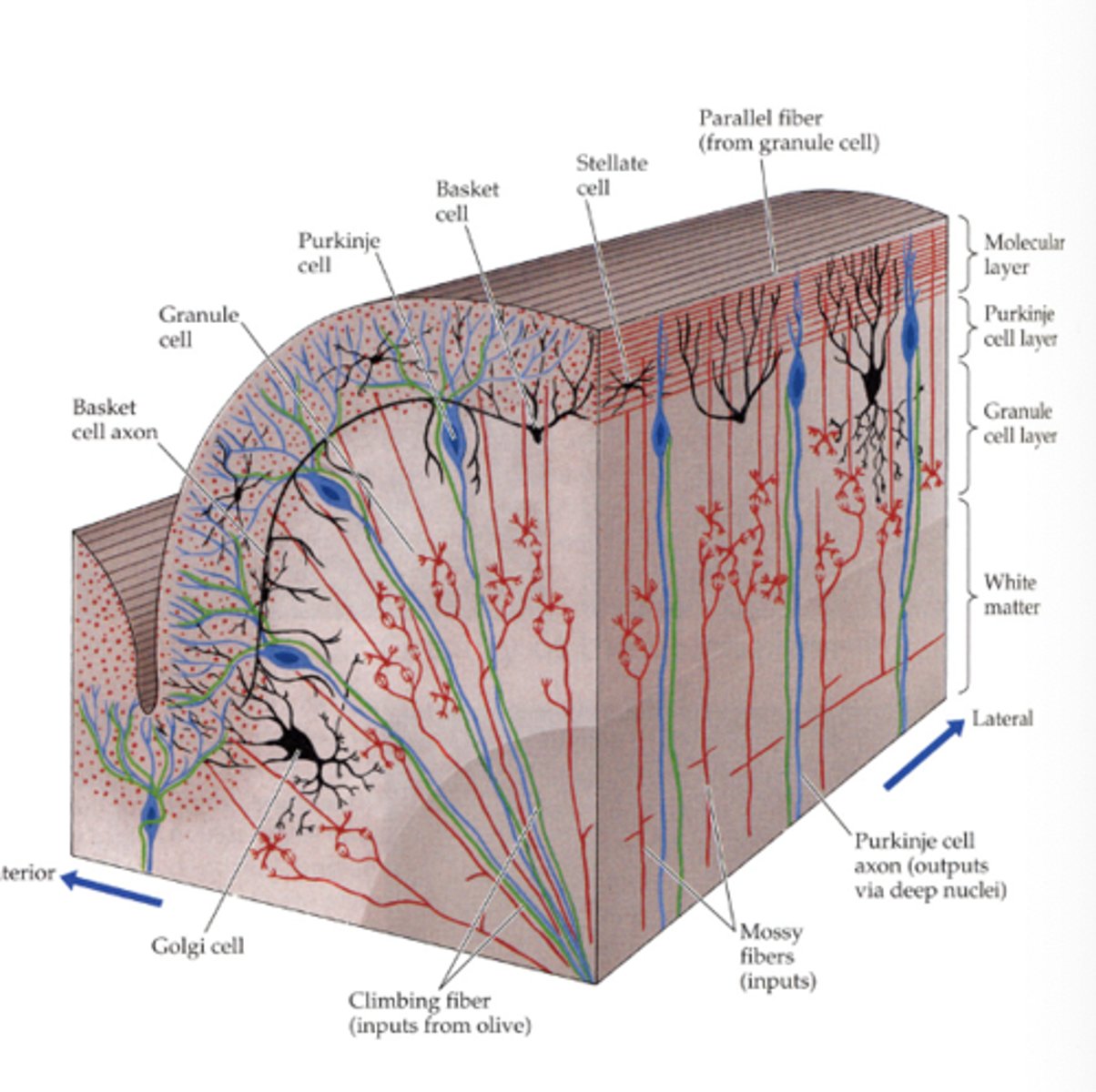
What are the mossy and climbing fibers that are within the cerebellum?
Excitatory inputs the feed into the cerebellum
What information do mossy fibers transmit?
somatosensory, arousal and balance info
What information do climbing fibers transmit?
information related to movement errors
What do the granule cells do within the cerebellum?
Receive excitatory input from mossy fibers
- Axons bifurcate to form parallel fibers which form excitatory synapses with numerous Purkinje cells

What do the purkinje neurons do within the cerebellum?
it is the only output cell from the cerebellar cortex and they inhibit the deep cerebellar/vestibular nuclei
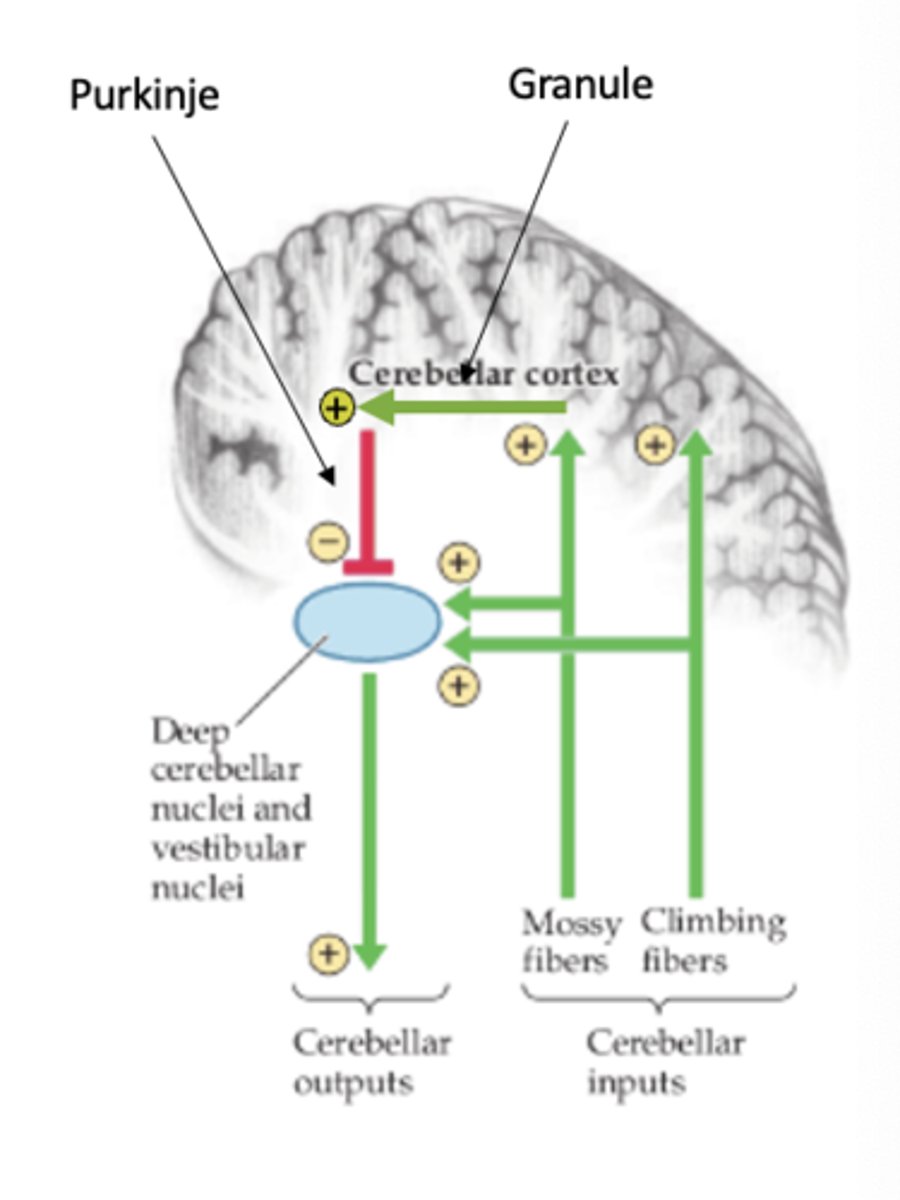
Where are the deep cerebellar nuclei embedded?
into white matter
How do the cells within the cerebellum work to help turn on and off the motor plan and refine movement?
- Input from mossy and climbing fibers excite nuclei, thus increasing firing rate
- Purkinje cells work to inhibit deep nuclei, thus decreasing firing rate
Excitation would work to "turn on" a motor plan and Inhibition would work to "turn off" a motor plan. Both of these working in tandem work to refine movement
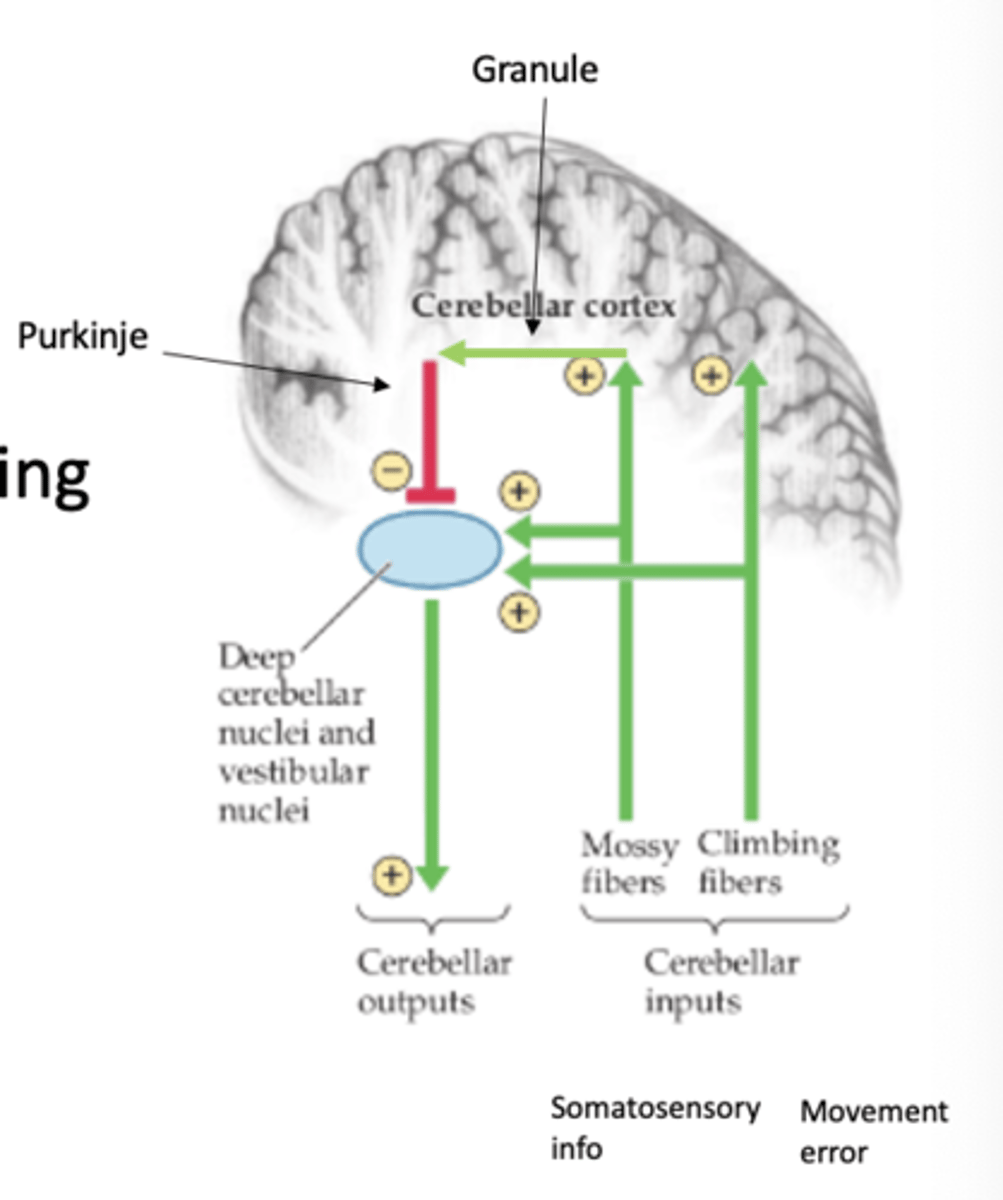
Most of the tracts of the cerebellum are...
ascending
What information is carried by the posterior (dorsal) spinocerebeller tract?
info from muscle spindles and Golgi Tendon Organs (mostly trunk and LE)
What is the function of the posterior (dorsal) spinocerebeller tract?
unconscious proprioception from lower body
What information is carried by the cuneocerebellar tract?
info from muscle spindles and Golgi Tendon Organs (mostly neck and upper extremity)
What is the function of the cuneocerebellar tract?
unconscious proprioception from upper body
What information is carried by the anterior (ventral) spinocerebeller tract?
Golgi Tendon Organ's and cutaneous receptors
What is the function of the anterior (ventral) spinocerebeller tract?
more sensory input. theory is that this information is related to intended movement
What information is carried by the rostrospinocerebellar tract?
Not known - likely GTOs and cutaneous receptors
What is the function of the rostrospinocerebellar tract?
not certain... UE equivalent to the anterior spinocerebeller?
Descending cortical output is about 21 million fibers, what do they do?
1 million descend as the corticospinal tract to activate alpha motor neurons
The other 20 million are corticopontine fibers that synapse at the pontine nuclei and send information to the cerebellum
What inputs into the cerebellum?
- Vestibular, visual, auditory and somatosensory
- Spinal cord (spinocerebellar pathways)
- Almost all areas of the cerebral cortex
- Brainstem (pontine nuclei)
What should be taken into account when thinking about parallel pathways and the cerebellum?
somatosensory information from the periphery is constantly being sent to both the cerebellum and the primary somatosensory cortex

Signs and symptoms of cerebellar injuries include...
- Ataxia
- Decomposition (Asynergia)
- Intention Tremor
- Dysmetria
- Dysdiadochokinesia
- Dysarthria
- Hypotonicity
- Nystagmus
- Balance and equilibrium
What is dysarthria?
lack of normal flow and rhythm of speech and lack of ability to coordinate the muscles necessary to make phonemes
What would be the cause of hypotonicity in someone with cerebellar injury?
due to damage of the vermis and fastigal nuclei
Examples of types of etiologies that lead to cerebellar damage include?
- Stroke
- TBI (most often due to "shearing" force but also direct force)
- MS
- Tumors
- Hydrocephalus with herniation (especially of cerebellar tonsils)
- Arnold Chiari
- Cerebral palsy
- Huntington's disease
- Hereditary cerebellar ataxia (e.g., Friedreich's Ataxia)
- Toxicity and Alcoholism